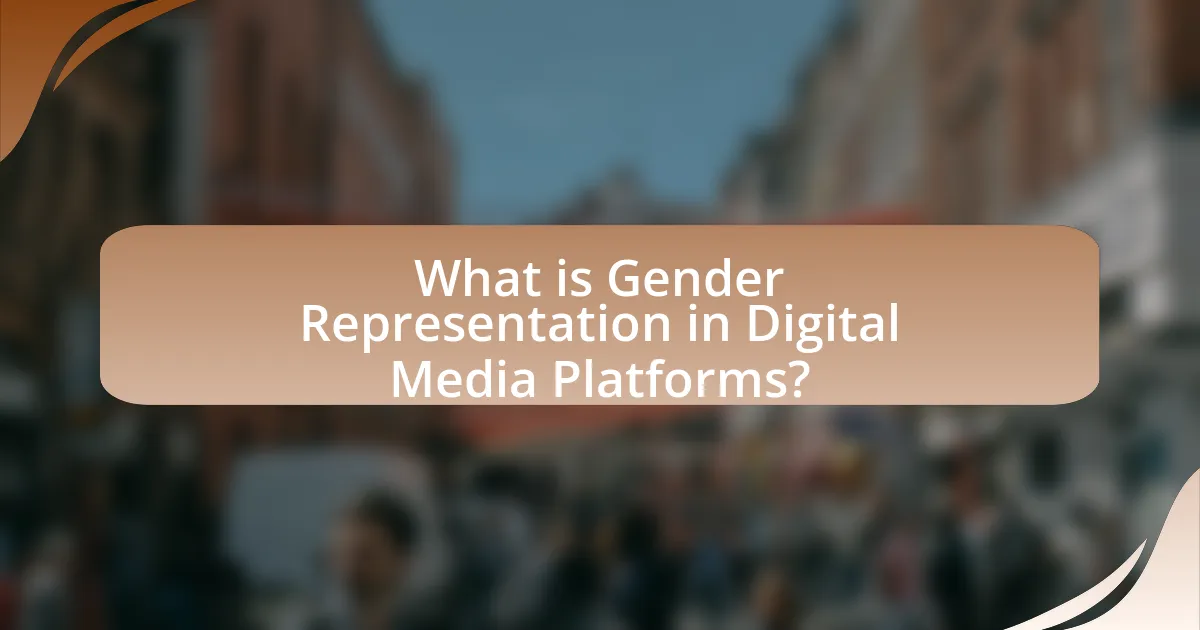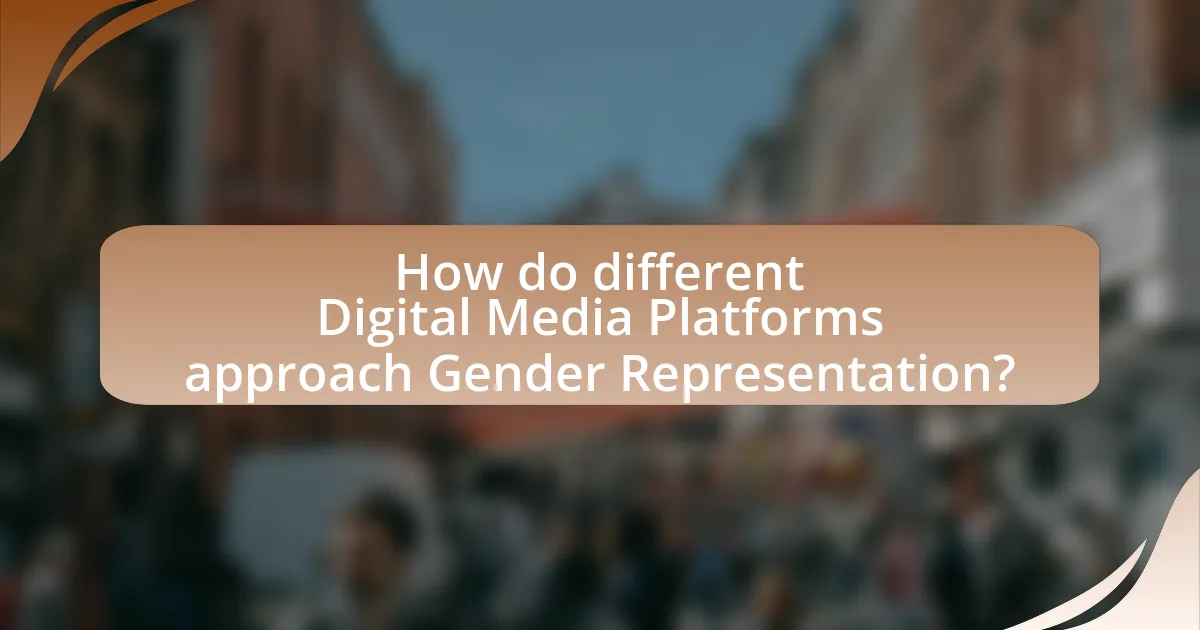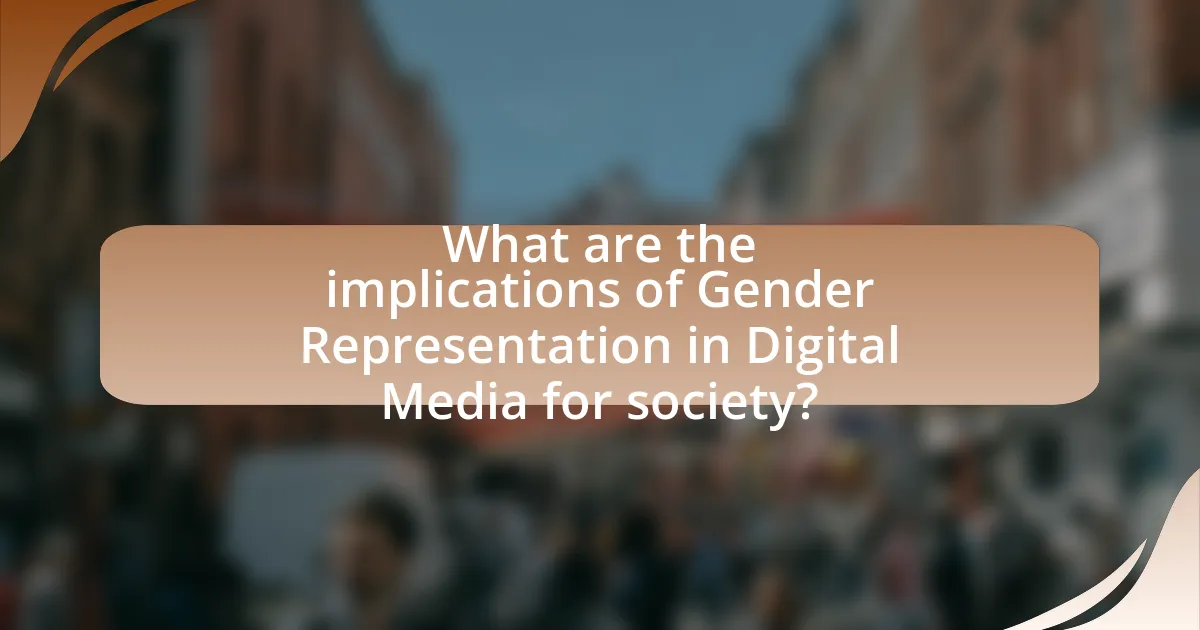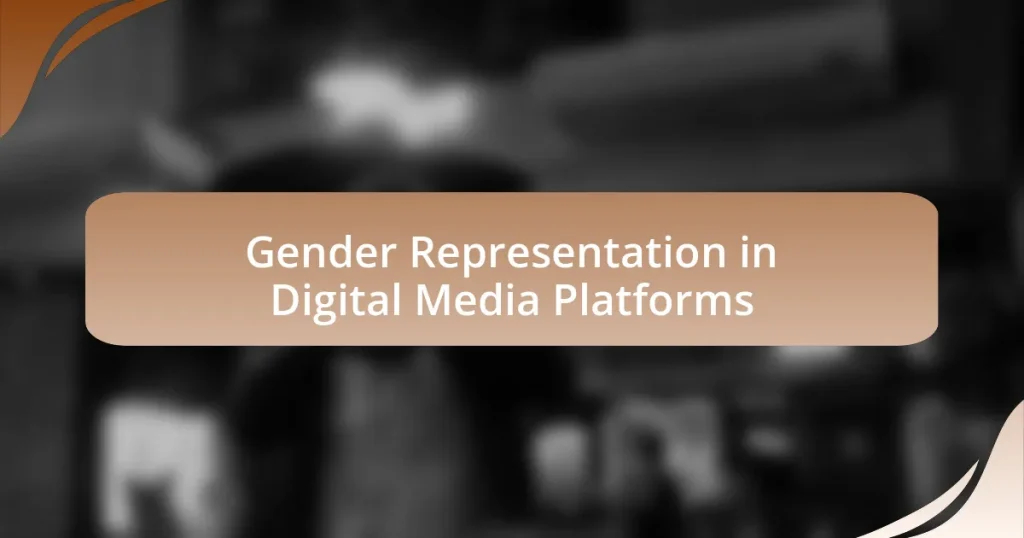Gender representation in digital media platforms encompasses the portrayal and visibility of various genders across online content, including social media, streaming services, and websites. This representation is vital as it shapes societal perceptions and norms regarding gender roles, with studies indicating that diverse portrayals lead to more inclusive narratives and better economic outcomes. The article explores the importance of gender representation, its impact on audience perception and societal norms, current trends, and the evolution of representation over the past decade. It also examines the challenges faced by digital media platforms in achieving balanced representation and highlights best practices for improving gender diversity in content creation.

What is Gender Representation in Digital Media Platforms?
Gender representation in digital media platforms refers to the portrayal and visibility of different genders within online content, including social media, streaming services, and websites. This representation is crucial as it influences societal perceptions and norms regarding gender roles. Studies indicate that diverse gender representation can lead to more inclusive narratives, with research showing that films and shows with balanced gender representation perform better both critically and commercially. For instance, a report by the Geena Davis Institute on Gender in Media found that films with female leads or co-leads had a 20% higher return on investment compared to those without. Thus, gender representation in digital media platforms plays a significant role in shaping cultural attitudes and economic outcomes.
Why is Gender Representation important in Digital Media?
Gender representation is important in digital media because it influences societal perceptions and reinforces or challenges stereotypes. Diverse representation allows for a more accurate reflection of society, promoting inclusivity and understanding among different genders. Research indicates that media portrayals can shape attitudes and behaviors; for instance, a study by the Geena Davis Institute on Gender in Media found that female characters in family films are often underrepresented, which can lead to skewed perceptions of gender roles among audiences. Thus, equitable gender representation in digital media is essential for fostering a balanced view of gender dynamics in society.
How does Gender Representation impact audience perception?
Gender representation significantly impacts audience perception by shaping societal norms and influencing individual attitudes. Research indicates that diverse and accurate portrayals of gender in media can lead to greater acceptance and understanding of different identities, while stereotypical representations often reinforce harmful biases. For instance, a study published in the Journal of Communication found that audiences exposed to balanced gender representation were more likely to support gender equality initiatives. This demonstrates that the way genders are depicted in digital media not only affects viewers’ perceptions of those genders but also their broader social attitudes and behaviors.
What role does Gender Representation play in shaping societal norms?
Gender representation plays a crucial role in shaping societal norms by influencing perceptions of gender roles and expectations. When media platforms portray diverse and equitable representations of genders, they challenge traditional stereotypes and promote a more inclusive understanding of gender identity. Research indicates that exposure to varied gender representations can lead to shifts in attitudes and behaviors, as seen in studies like “The Impact of Media Representation on Gender Stereotypes” published in the Journal of Communication, which found that positive portrayals of women in media correlate with increased support for gender equality. Thus, gender representation in digital media not only reflects but also actively shapes societal norms regarding gender.
What are the current trends in Gender Representation on Digital Media Platforms?
Current trends in gender representation on digital media platforms show an increasing focus on diversity and inclusivity. Research indicates that platforms like Instagram and TikTok are amplifying voices from various gender identities, with a notable rise in content created by non-binary and transgender individuals. According to a 2022 report by the Geena Davis Institute on Gender in Media, women now represent 50% of characters in streaming content, a significant increase from previous years. Additionally, social media campaigns advocating for gender equality are gaining traction, leading to more balanced portrayals in advertising and influencer marketing. This shift reflects a broader societal demand for authentic representation and challenges traditional gender norms.
How has Gender Representation evolved over the past decade?
Gender representation has significantly improved over the past decade, with increased visibility and participation of women and non-binary individuals in various media forms. Research indicates that female characters in film and television have risen from 30% in 2012 to approximately 50% in 2022, reflecting a more balanced portrayal. Additionally, studies show that women now direct about 20% of films, a notable increase from just 5% a decade ago. This evolution is supported by initiatives like the 50/50 by 2020 campaign, which aimed to achieve gender parity in media representation.
What are the most common stereotypes associated with Gender Representation in Digital Media?
The most common stereotypes associated with gender representation in digital media include the portrayal of women as overly sexualized objects, while men are often depicted as dominant and aggressive. Research indicates that women are frequently shown in roles that emphasize beauty and submissiveness, reinforcing traditional gender roles. For instance, a study by the Geena Davis Institute on Gender in Media found that female characters are often underrepresented and depicted in a limited range of roles, with 29% of female characters in family films being shown in sexually revealing clothing. Conversely, male characters are typically portrayed in positions of power and authority, which perpetuates the stereotype of masculinity linked to strength and control. This disparity in representation contributes to societal perceptions and expectations regarding gender roles.

How do different Digital Media Platforms approach Gender Representation?
Different digital media platforms approach gender representation through varying strategies and policies that reflect their target audiences and corporate values. For instance, social media platforms like Instagram and TikTok often promote diverse gender representations by encouraging user-generated content that showcases a wide range of identities, which has been linked to increased visibility and acceptance of non-binary and transgender individuals. In contrast, streaming services like Netflix have made significant strides in gender representation by producing original content that features strong female leads and LGBTQ+ characters, as evidenced by their commitment to gender parity in their productions, which was highlighted in their 2020 diversity report. Additionally, gaming platforms are increasingly focusing on inclusive character design and narratives that challenge traditional gender roles, as seen in titles like “The Last of Us Part II,” which received acclaim for its portrayal of complex female characters. These approaches indicate a broader trend towards inclusivity and representation across various digital media platforms, reflecting societal shifts in understanding gender diversity.
What strategies do social media platforms use to promote Gender Representation?
Social media platforms promote gender representation through targeted initiatives such as algorithm adjustments, diverse content promotion, and partnerships with advocacy organizations. These platforms often modify their algorithms to prioritize content that showcases diverse voices and perspectives, ensuring that users encounter a wider range of gender representations. For instance, Instagram has implemented features that highlight female creators and their work, increasing visibility for underrepresented genders. Additionally, platforms like Twitter and Facebook collaborate with organizations focused on gender equality to create campaigns that raise awareness and encourage inclusive dialogue. Research indicates that these strategies can lead to a more balanced representation, as seen in studies showing increased engagement with content featuring diverse gender identities.
How do algorithms affect Gender Representation on these platforms?
Algorithms significantly influence gender representation on digital media platforms by determining which content is prioritized and displayed to users. These algorithms often reflect existing biases, leading to the underrepresentation of women and non-binary individuals in various media forms. For instance, a study by the Geena Davis Institute on Gender in Media found that women are often depicted in stereotypical roles, and algorithms that favor popular content can perpetuate these stereotypes by promoting male-dominated narratives. Additionally, research published in the journal “Social Media + Society” indicates that algorithmic bias can result in less visibility for female creators, impacting their reach and engagement compared to their male counterparts. This systemic bias in algorithmic design ultimately shapes the overall narrative and representation of gender on these platforms.
What initiatives have been taken by platforms to improve Gender Representation?
Platforms have implemented various initiatives to improve gender representation, including diversity hiring practices, mentorship programs, and content guidelines promoting inclusive narratives. For instance, major streaming services have committed to increasing the number of female directors and writers in their projects, with Netflix reporting a 50% increase in female representation among its directors from 2018 to 2021. Additionally, social media platforms have launched campaigns to highlight female creators and provide funding for projects led by women, such as YouTube’s Creators for Change initiative, which supports content that addresses social issues, including gender equality. These efforts are aimed at creating a more balanced representation of genders in digital media.
How do streaming services handle Gender Representation in their content?
Streaming services handle gender representation in their content by actively promoting diverse and balanced portrayals of genders in their programming. For instance, platforms like Netflix and Amazon Prime Video have implemented initiatives to increase the visibility of female characters and stories, often commissioning projects that focus on women’s experiences and perspectives. According to a 2021 report by the Geena Davis Institute on Gender in Media, female characters in streaming content have increased to 47% in leading roles, reflecting a commitment to gender parity. Additionally, many streaming services have established guidelines and partnerships aimed at improving gender representation behind the scenes, such as hiring more women in directing and writing roles, which further influences the narratives presented.
What are the challenges faced by streaming services in achieving balanced Gender Representation?
Streaming services face significant challenges in achieving balanced gender representation, primarily due to industry biases, lack of diverse leadership, and audience expectations. Industry biases often result in the underrepresentation of women in key creative roles, such as directors and writers, which limits the diversity of stories told. A report from the Geena Davis Institute on Gender in Media indicates that only 18% of directors of the top 100 grossing films in 2019 were women, reflecting a broader trend in media. Additionally, the lack of diverse leadership within streaming platforms can perpetuate these biases, as decision-makers may favor projects that align with traditional gender norms. Audience expectations also play a role; studies show that viewers may unconsciously prefer content that reflects existing stereotypes, making it challenging for streaming services to prioritize gender-balanced narratives. These factors collectively hinder the progress toward equitable representation in streaming content.
How do viewer demographics influence Gender Representation in streaming content?
Viewer demographics significantly influence gender representation in streaming content by shaping the types of narratives and characters that are prioritized. For instance, platforms often analyze viewer age, gender, and cultural background to tailor content that resonates with their audience, leading to a predominance of certain gender portrayals that align with demographic preferences. Research indicates that younger audiences tend to favor diverse and complex female characters, prompting streaming services to invest in content that reflects these preferences, such as shows featuring strong female leads. Additionally, data from the Geena Davis Institute on Gender in Media reveals that films and series with a higher percentage of female viewers tend to feature more balanced gender representation, demonstrating a direct correlation between viewer demographics and the portrayal of gender in streaming content.

What are the implications of Gender Representation in Digital Media for society?
Gender representation in digital media significantly influences societal norms and perceptions. When media portrays diverse and accurate representations of gender, it can challenge stereotypes and promote equality, leading to a more inclusive society. For instance, research from the Geena Davis Institute on Gender in Media indicates that female characters in family films have increased from 30% in 2006 to 50% in 2019, reflecting a shift towards more balanced representation. This shift can positively impact young audiences by providing role models and fostering a sense of belonging. Conversely, underrepresentation or negative portrayals can reinforce harmful stereotypes, perpetuating discrimination and limiting opportunities for marginalized genders. Thus, the implications of gender representation in digital media are profound, shaping societal attitudes and behaviors towards gender equality.
How does Gender Representation influence youth and identity formation?
Gender representation significantly influences youth and identity formation by shaping perceptions of gender roles and self-identity. Research indicates that exposure to diverse and accurate representations of gender in digital media can lead to more inclusive attitudes and a broader understanding of gender identity among young people. For instance, a study published in the Journal of Youth and Adolescence found that adolescents who engage with media featuring varied gender representations are more likely to develop positive self-concepts and challenge traditional gender norms. This highlights the critical role that media plays in informing youth about gender diversity and its implications for their own identities.
What are the psychological effects of Gender Representation on young audiences?
Gender representation significantly influences the psychological development of young audiences by shaping their self-perception and social identity. Research indicates that exposure to diverse and balanced gender representations in media can enhance self-esteem and promote positive role models, while stereotypical portrayals can lead to internalized biases and limited aspirations. For instance, a study published in the journal “Psychology of Popular Media Culture” found that children who viewed media with equitable gender representation exhibited higher levels of confidence and ambition compared to those exposed to traditional gender stereotypes. This highlights the critical role that media plays in either reinforcing or challenging societal norms regarding gender, ultimately affecting young audiences’ psychological well-being and worldview.
How can positive Gender Representation contribute to social change?
Positive gender representation can significantly contribute to social change by challenging stereotypes and promoting equality. When media platforms showcase diverse and realistic portrayals of all genders, they help to reshape societal norms and expectations. For instance, research by the Geena Davis Institute on Gender in Media indicates that films with strong female characters can inspire young girls to pursue careers in fields traditionally dominated by men, such as science and technology. This shift not only empowers individuals but also fosters a more inclusive society, ultimately leading to greater gender equality in various sectors.
What are the best practices for improving Gender Representation in Digital Media?
To improve gender representation in digital media, organizations should implement diverse hiring practices, ensure equitable content creation, and actively promote female voices. Diverse hiring practices lead to a workforce that reflects various gender identities, which enhances creativity and relatability in content. Research from the Geena Davis Institute on Gender in Media indicates that films with female directors have a higher percentage of female characters, demonstrating the impact of diverse leadership on representation. Additionally, equitable content creation involves analyzing existing media for gender bias and actively seeking to correct it, ensuring that women are not only represented but also portrayed in multifaceted roles. Promoting female voices through initiatives like mentorship programs and funding for women-led projects can further amplify underrepresented perspectives, fostering a more inclusive media landscape.
How can content creators ensure diverse and accurate Gender Representation?
Content creators can ensure diverse and accurate gender representation by actively including a variety of gender identities and experiences in their narratives and character development. This approach involves conducting thorough research on gender diversity, consulting with individuals from different gender backgrounds, and incorporating their perspectives into the content. For instance, studies show that media representation significantly influences societal perceptions of gender roles; the Geena Davis Institute on Gender in Media found that female characters in film and television are often underrepresented, which can perpetuate stereotypes. By prioritizing authentic storytelling that reflects the complexity of gender identities, content creators can foster a more inclusive media landscape.
What role do audiences play in advocating for better Gender Representation?
Audiences play a crucial role in advocating for better gender representation by actively demanding diverse and equitable portrayals in media. Their engagement, through social media campaigns, petitions, and viewership choices, influences content creators and platforms to prioritize gender diversity. For instance, the #MeToo movement, which gained momentum through audience participation, highlighted the need for more female voices in storytelling, leading to increased awareness and changes in industry practices. Research indicates that when audiences express dissatisfaction with gender representation, it prompts companies to adjust their strategies to meet consumer expectations, thereby fostering a more inclusive media landscape.










